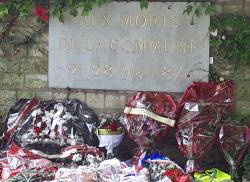By John Pickard
The Pere Lachaise cemetery is in the 20th Arrondisement of Paris. At each entrance there are signs with diagrams showing the location of the tombs of famous people like Oscar Wilde, Honore de Balzac, Georges Bizet and Frederic Chopin. However, I didn’t see any mention of the position of the graves of Laura and Paul Lafargue, Karl Marx’s daughter and son-in-law or any indication that opposite the Lafargue’s tombstones is the Wall of the Communards.
The Communards’ Wall commemorates the last stand of the Paris Commune, which had lasted from March 18 to May 28 1871 and was the first-ever example of a workers’ government, albeit one that only lasted weeks. The Commune was eventually crushed with great bloodshed. The last 200 or so communards, many of them severely wounded and all of them exhausted made a final stand at the Pere Lachaise cemetery. Here they eventually surrendered to overwhelming French government forces. The prisoners were made to dig their own mass grave and then were summarily executed, shot against the wall that is now known as the Communards’ Wall. Thousands more were captured and killed elsewhere around Paris.
I just happened to visit the Pere Lachaise cemetery on May 28th, the 148 anniversary of the end of the Commune and it was very gratifying to see that there were fresh flowers and wreathes placed against the wall. I don’t know whose ceremony it was, but clearly there had been a ceremony of sorts.
Pere Lachaise cemetery is a very moving place. Apart from the Communards’ Wall and the graves of the Lafargues, there are several monuments to the tens of thousands of Parisians who were deported to Nazi concentration camps, each camp with its own monument, and each monument, it seemed was an arresting and sombre work of sculpture. There were also many tombstones for heroic Parisians or small groups of Resistance fighters who had been captured and executed by the Nazis, including a young school student of 17 years of age. As well as fighters in the Resistance and those, mainly Jews, who were deported directly to the extermination camps, there were tens of thousands more Parisians who deported for forced labour. Many of these were literally worked to death. All of them are remembered in this particular cemetery.
Fixed alongside the outside wall of the cemetery is a memorial to the fallen of the First World War. Imagine a marble plaque, with the names in columns and grouped by the year in which they were killed. Each name is perhaps a centimetre high and each column is therefore three inches wide and has perhaps twenty names from top to bottom. Then you realise that this plaque is literally a quarter of a mile long and so the number of names simply beggars belief. Then, more, you need to remember than these are the names of the dead from one war and only from Paris. Every town and city in the country has its own wall or memorial to their own dead of World War I.
If you go to Paris, go to the Pere Lachaise cemetery: Metro station, Pere Lachaise.
June 3, 2019



